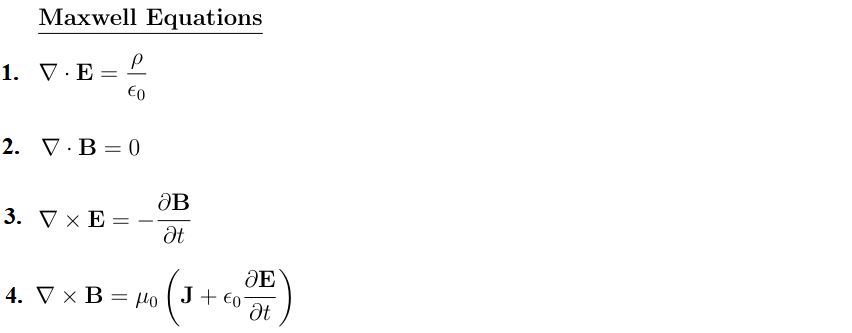Electromagnetism Notes: Electromagnetism is a branch of physics that deals with the study of electric and magnetic fields, their interactions, and their effects on matter. It forms the foundation for many modern technologies and scientific advancements. It forms a part of the class 10 and class 12 curriculum and is also discussed in detail in Engineering Physics. Here, we have explained Electromagnetism for students of all grades making it easier for them to understand the term and learn about the key concepts, formulas and applications of Electromagnetism. Check and download PDF of Electromagnetism notes below:
Definition of Electromagnetism
Electromagnetism is defined as a phenomenon in which a magnetic field is generated with the help of the current in the conductor. Electromagnetism is made of two different aspects - electricity and magnetism.
Electromagnet
An electromagnet is a type of magnet in which the magnetic field is produced by an electric current.
Electromagnets usually consist of a coil of wire, often wrapped around a core made of ferromagnetic material like iron. When an electric current flows through the wire, it generates a magnetic field, which magnetizes the core, producing a strong magnetic effect. The strength of the magnetic field can be controlled by varying the amount of electric current flowing through the coil.
Properties of Electromagnets
- Electromagnets are made of soft iron core.
- These are temporary magnets in which magnetic field vanishes as the current is stopped.
- The strength of magnetic field in an electromagnet can be easily changed by varying the amount of electric current passing through the coil
- Magnetic poles can be reversed by changing the direction of flow of the electric current.
Mechanics: Definition, Types, Concepts, Applications and More
Thermodynamics: Definition, Types, Concepts, Applications and More
Key Concepts of Electromagnetism
1.Electric Charge:
- Fundamental property of matter, existing in two types: positive and negative.
- Like charges repel, opposite charges attract.
- Measured in coulombs (C).
2.Electric Field (E):
- It is theregion around a charged particle where other charges experience a force.
- It is a vector quantity and denoted by E.
- Represented by field lines pointing away from positive charges and towards negative charges.
Mathematically:
- E = F/q
- E = Electric field (N/C)
- F = Force (N)
- q = Test charge (C)
3.Magnetic Field (B):
- A region where a magnetic force is experienced by moving charges or magnetic materials.
- Represented by field lines forming closed loops from the north to the south pole.
- Measured in teslas (T).
4.Electromagnetic Force:
- One of the four fundamental forcesthat describes the interactions between electrically charged particles.
- Also called the Lorentz force.
- Responsible for the behavior of charged particles and the propagation of electromagnetic waves.
Laws and Equations used in Electromagnetism
1.Coulomb's Law:
Describes the force between two point charges.
F = ke (q1q2/r2)
- F = Force (N)
- ke= Coulomb's constant (8.99×109 N m2/C2)
- q1,q2 = Charges (C)
- r = Distance between charges (m)
2.Gauss's Law:
Relates the electric flux through a closed surface to the charge enclosed by the surface.
∮E.dA=Q/ϵ0
- E = Electric field (N/C)
- dA= Differential area vector (m²)
- Q = Enclosed charge (C)
- ϵ0= Permittivity of free space (8.85×10−12 C2/N m2)
3.Ampere's Law:
Relates the magnetic field around a closed loop to the current passing through the loop.
∮B.dl=μ0I
- B= Magnetic field (T)
- dl= Differential length vector (m)
- μ0 = Permeability of free space (4π×10−7 T m/A)
- I= Enclosed current (A)
4.Fraday's Law of Electromagnetic Induction:
Describes how a changing magnetic field induces an electric field.
ε = −d ΦB/dt
- ε= Induced electromotive force (V)
- ΦB= Magnetic flux (Wb)
- t = Time (s)
5.Lenz's Law:
- States that the direction of the induced current is such that it opposes the change in magnetic flux.
- Incorporated in Faraday’s Law with the negative sign.
6.Maxwell's Equations:
Four fundamental equations describing electromagnetism.
- Gauss's Law for Electricity: ∇.E= ρ/ϵ0
- Gauss's Law for Magnetism: ∇.B= 0
- Faraday's Law of Induction: ∇×E=−∂B/∂t
- Ampère's Law (with Maxwell’s addition): ∇×B= μ0J + μ0ϵ0(∂E/∂t)
Refraction Of Light: Definition, Laws, Applications And FAQs
Newton’s Laws Of Motion: Definition, Formula, Applications And Examples
Applications of Electromagnetism in the Real World
1. Electric Power Generation and Transmission:
- Power plants convert mechanical energy to electrical energy using electromagnetic induction.
- Transformers and power lines use electromagnetic principles to transmit electricity efficiently over long distances.
2. Electronics and Communication:
- Devices like radios, televisions, and smartphones rely on electromagnetic waves for signal transmission.
- Semiconductors and circuit components operate based on electromagnetic principles.
3. Medical Imaging and Equipment:
- MRI machines use strong magnetic fields and radio waves to create detailed images of the inside of the body.
- X-ray machines and CT scanners utilize electromagnetic radiation for diagnostic imaging.
4. Motors and Generators:
- Electric motors convert electrical energy into mechanical work using electromagnetic fields.
- Generators do the reverse, converting mechanical work into electrical energy.
5. Household Appliances:
- Induction cooktops use electromagnetic fields to directly heat pots and pans.
- Microwave ovens use electromagnetic waves to heat food.
6. In Everyday Life:
- Compasses use the Earth's magnetic field to show direction.
- Magnetic locks and card readers utilize magnetic strips for security and data access.
Download the above notes in PDF below:
| Electromagnetism Notes in PDF |
You can also access video lectures for major topics of Physics, Chemistry and Maths to get a better concept clarity and achieve success in your academics. Find the video link below:
To get more knowledge on advanced Physics topics and other subjects refer to the links below or check the official website of Jagran Josh.


Comments
All Comments (0)
Join the conversation